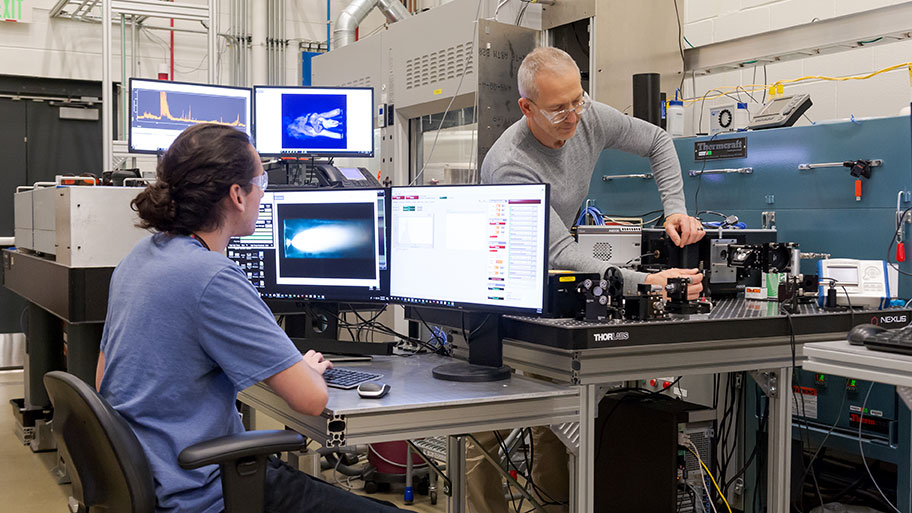Scaling up production of new energy materials may get easier with machine learning.
By Joan Koka
To double the range of electric vehicles, or increase the efficiency of fuel cells, the world will likely need better materials.
Identifying these materials is one challenge but producing them at scale can prove to be an even greater hurdle.
One way of producing large quantities of nanomaterials, which are from 1 to 100 nanometers in size, is through flame spray pyrolysis (FSP), a process that synthesizes nanomaterials by igniting a chemical spray and producing chemical reactions in the flame. (There are one billion nanometers in a meter.)
If carefully controlled, FSP could help scale the production of a wide range of materials, from battery cathodes to chemical catalysts. However, the complicated process is hard to understand and control, even with the most advanced diagnostic tools.
At the U.S. Department of Energy’s Argonne National Laboratory, researchers are developing strategies to overcome this challenge in order to create high-quality materials with a desired set of attributes. In a paper published in Materials & Design, the team demonstrated that artificial intelligence (AI) can help to optimize the FSP process.
In their study, the researchers show that an AI technique known as active machine learning can optimize FSP to produce silica particles of a desired size. This demonstration shows that AI can fine tune the complex process just as well, if not better, than humans can.
“In FSP there are all these variables that impact the quality of the particle. What active machine learning allows us to do is quickly explore a large number of these, something a human would never be able to do because the dimensionality of the space is just too high,” said Argonne computational materials scientist Noah Paulson, lead author of the paper.

Joseph Libera and Anthony Stark prepare for in-situ Raman spectroscopy.
(Image by Argonne National Laboratory.)
Broadly speaking, machine learning algorithms work by learning patterns and relationships within data and using them to predict outcomes. Argonne’s research team used these tools to relate the inputs for FSP (concentration of reagents, flow rates, and other operating conditions) to output measures such as particle size distribution.
Iteratively feeding input and output data into their machine learning algorithms yielded a model that could reliably identify the optimal FSP inputs needed to achieve particles of a desired size distribution. Though demonstrated on silica, this same approach can be used to optimize FSP for the production of other types of materials.
“In active learning, one needs to retrain the machine learning algorithm over small intervals of time, as more data is acquired. What we gain from doing this is more a more accurate representation of the system, which makes the model and predictions better,” said Marius Stan, the Intelligent Materials Design lead at Argonne’s Applied Materials Division.
Using machine learning to optimize the FSP process would help minimize the number of physical experiments scientist would need to do to find the right operating conditions for achieving an optimal result. These methods can also point out relationships between inputs and outputs that technologists otherwise can’t see because of the sheer complexity of the data.
“There could be a complex combination of parameters that relate to an output that we would never be able to grasp just looking at reams of numbers. When those things are identified, then the information becomes actionable. We can start to postulate what the physics might be and that could lead us to a better understanding of the physics and the chemistry of the process,” said Joe Libera, a principal materials scientist who operates the laboratory’s flame spray pyrolysis setup.
Stan notes that various AI components such as machine learning, computer vision and natural language processing can also mediate the discovery of new materials.
“It’s feasible and I would say even probable that these types of technologies at some point will lead us to new materials with extraordinary properties,” he said.
Looking ahead, researchers hope to use computational and diagnostics methods together to gain a better understanding of the underlying physics of FSP and how to control the system. These insights can lead to the production of better-performing materials while reducing the time needed to discover and optimize new materials.
“If we can find a way to translate the successes that we see in the lab to materials that can be manufactured at reasonable costs, then we can enable those technologies that the world really needs,” Paulson concludes.
The study, titled “Flame spray pyrolysis optimization via statistics and machine learning” is published in the journal Materials & Design.
This work was funded by Argonne’s Laboratory Directed Research & Development (LDRD) program, and used resources at Argonne’s Materials and Engineering Research Facility.
Video tour of the flame spray pyrolysis experimental area:

Joan Koka
Joan Koka is a marketing consultant and writer with years of experience developing communications for the energy and manufacturing sector. She helps entrepreneurs and organizations in this space raise awareness around new energy technologies through content marketing, SEO and writing.
Scott Ellyson, CEO of East West Manufacturing, brings decades of global manufacturing and supply chain leadership to the conversation. In this episode, he shares practical insights on scaling operations, navigating complexity, and building resilient manufacturing networks in an increasingly connected world.